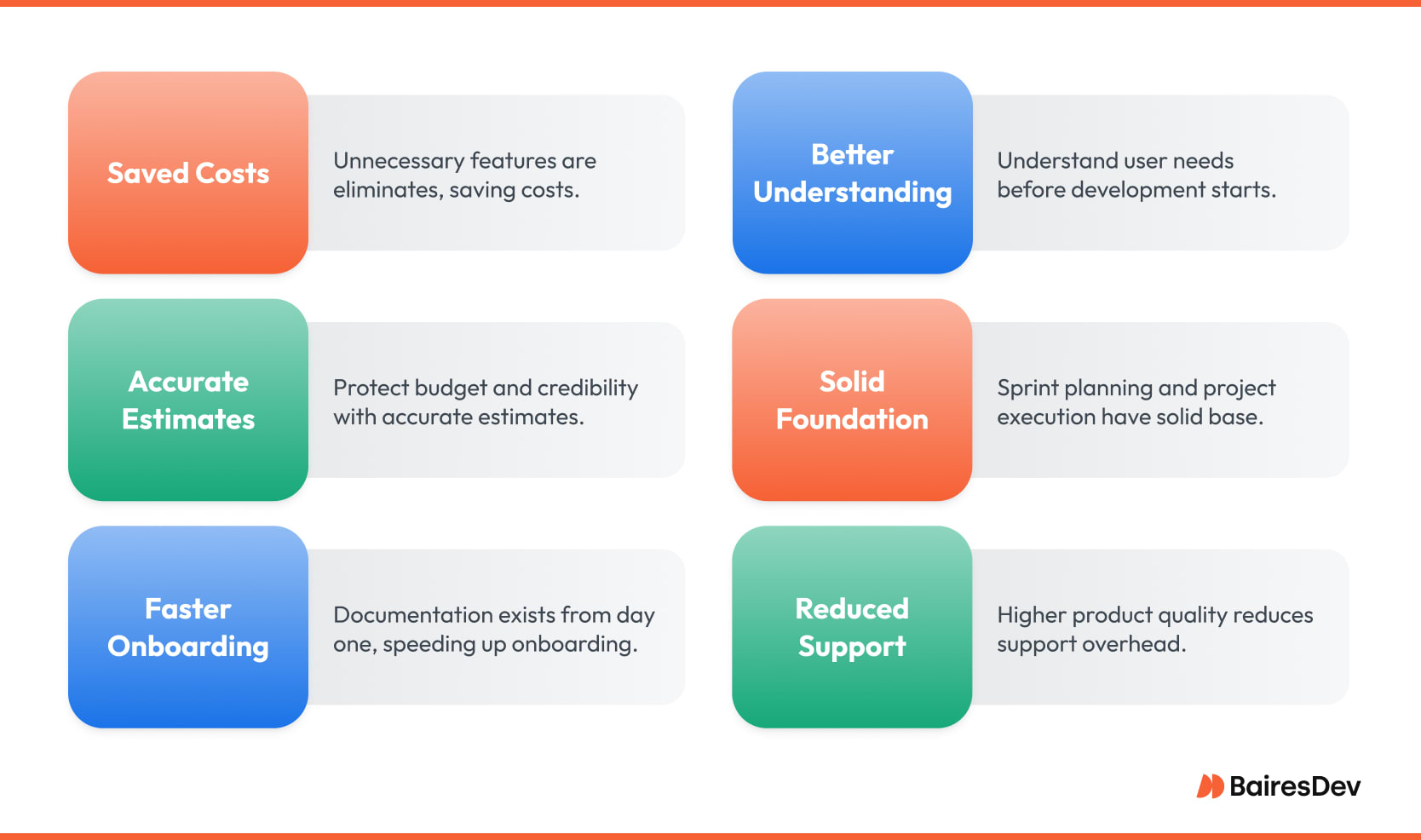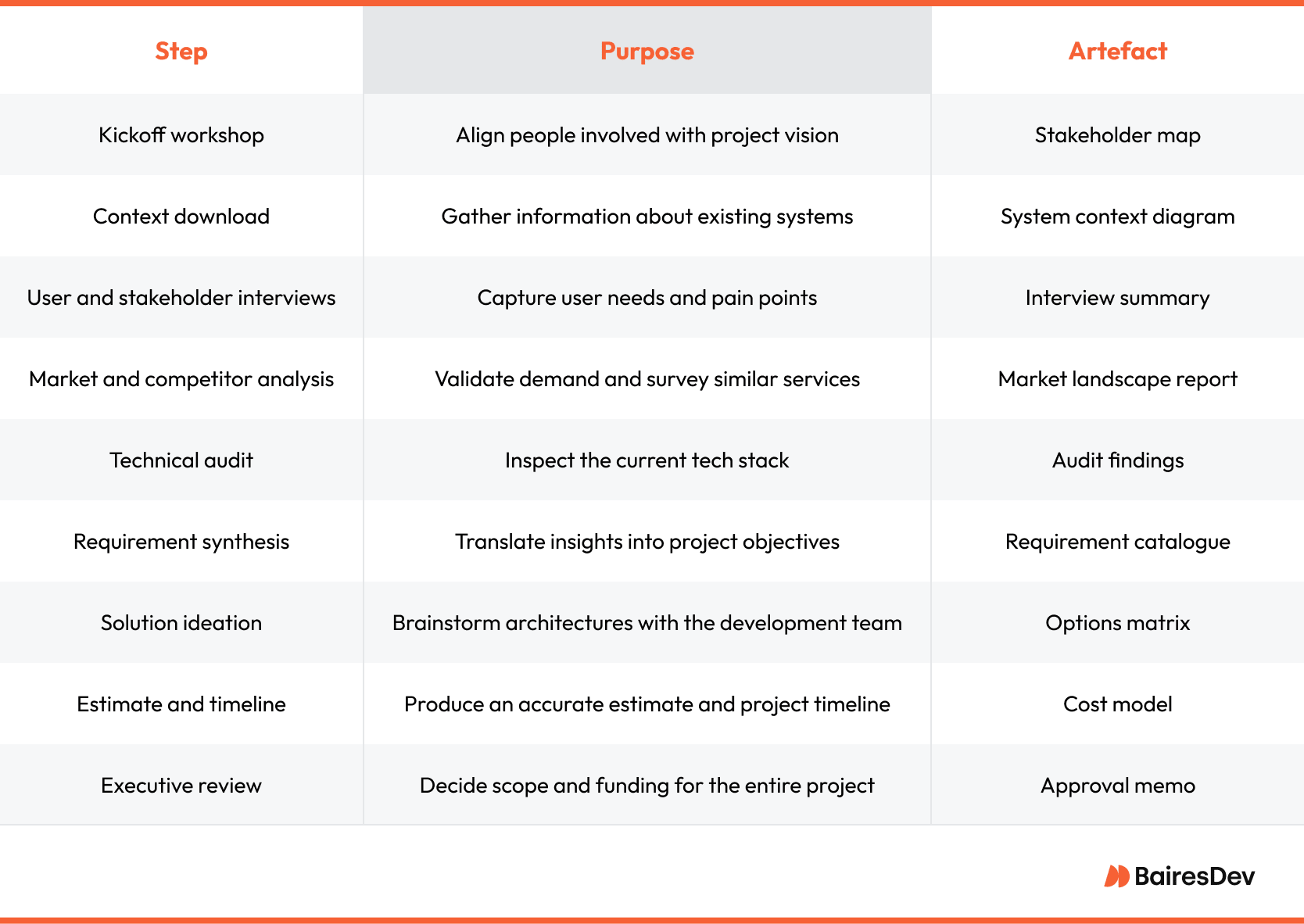Every effective software project begins with a rigorous discovery phase. Companies that overlook this early stage see scope expand, velocity slow, and trust evaporate. Leaders who invest in disciplined discovery gain a solid foundation, a realistic budget, and a shared product vision that allows the project team to deliver with confidence.
This article explains how to conduct discovery like a mature enterprise operation and why that effort pays dividends throughout the entire project lifecycle.
What the Project Discovery Phase Achieves
Project discovery is when the project team gathers information, validates assumptions, and aligns the product vision with business goals. The process answers three executive questions.
- Is the product viable for the target market and potential customers?
- Can the development team build and scale it within the available time and budget?
- How do we avoid costly changes once development starts?
By confronting those questions at the start, the project manager protects budget, the development team eliminates ambiguity, and executives receive precise project boundaries that keep scope creep out of later sprints.

Case Insight: Rapid Modernisation of a Legacy Platform
In the discovery phase, BairesDev and our client, Associated Press, identified the formats and features that media outlets currently required, the current state of their Classic ASP platform, and blue-sky solutions for the future.
With every need identified, the team mapped out the technical solutions needed to give the Associated Press and its customers a platform that was flexible and scalable.
Early Stage Alignment: Vision, Goals, and Boundaries
Discovery begins before any design file or code branch exists. The business analyst, project manager, and technical leads meet key stakeholders to translate strategic intent into measurable project goals. They convert phrases such as improve conversion rate into objectives with numeric targets. Those specific targets become the north star for the discovery team because they reveal what to measure and clarify the desired outcome.
Next, the team drafts a concise charter that defines the target audience, potential users, and core features. The document lists assumptions, constraints, and acceptance criteria. With that charter in place, every person involved stays on the same page and conversations about project scope move from opinion to evidence.
The Discovery Team: Roles and Responsibilities
A disciplined discovery process relies on a small but senior team.
- Project Manager. Orchestrates milestones, handles risk, and maintains transparent communication.
- Business Analyst. Maps business processes, conducts user interviews, and writes user stories that express user needs in clear language.
- Technical Lead. Audits the current technical stack, estimates effort, and sketches the high-level architecture.
- User Experience Researcher. Studies the user journey and informs information architecture choices.
Each role focuses on facts rather than opinions. Their combined output provides an accurate estimate that executives can trust during budget review.
Gathering Information and Exploring the Problem Space
Discovery favors direct evidence over assumption, but how do we gather the facts and steer clear of bias?
The team interviews potential users, observes their workflows, and catalogs pain points. They use surveys and competitor analysis to test the value proposition against the wider market. When data contradicts an internal belief, they update the product vision rather than ignore the signal. This willingness to refine helps minimize waste and maintain focus.
Market research quantifies opportunity size. Google Trends, analyst reports, and open data reveal whether similar services already dominate the space. A discovery team that confronts market reality can adjust feature priorities before a line of code is written.
Technical Archaeology: Understanding the Current State
Many enterprise engagements involve legacy estates rather than greenfield software development projects. Older frameworks, brittle integrations, and undocumented conventions hide technical requirements that can derail the most conservative schedule. This is why technical archaeology plays a key role in the discovery process.
Engineers walk the repository, record dependency lists, and map deployment workflows. They review incident history and post-mortems to expose recurring weaknesses. They evaluate infrastructure spend to see whether the current cloud footprint aligns with projected demand. The output is a risk matrix that pairs every threat with a mitigation plan, for example, replacing unsupported libraries or upgrading deprecated frameworks.
Defining the Technical Solution and Development Roadmap
Only after the team sees the full picture do they outline solution scenarios. For each scenario they score benefit, complexity, and alignment with business goals. The evaluation matrix remains visible to stakeholders so trade-offs feel transparent rather than political.
The technical lead draws an architecture diagram from the preferred scenario. Next, the team converts epics into user stories and loads an initial backlog. Story point totals generate a project timeline and a development roadmap that highlights proof of concept, pilot release, and general availability.
Teams that establish this roadmap during discovery can communicate progress in language both engineers and executives understand.
Building a Continuous Integration Pipeline During Discovery
Modern delivery culture expects rapid feedback loops. Discovery prepares for that expectation by creating or refining the continuous integration and delivery pipeline.
Engineers configure automated unit tests, static analysis, and container builds so that quality gates catch defects minutes after a merge. Testing early protects project objectives, because defects that escape to production cost an order of magnitude more to fix.
Governance, Risk, and Compliance
Regulated industries demand evidence that the software development process follows accepted standards. Discovery produces that evidence: requirements traceability, architecture decision records, and security checklists map back to frameworks such as SOC2, PCI, or ISO27001. Governance artefacts reassure both auditors and executives that the project will satisfy external obligations without hindering velocity.
Measuring Success
The discovery phase is complete only when the project team can present these items.
- A validated backlog with prioritised user stories.
- A cost and schedule forecast that the finance team can model.
- A definition of done connected to success metrics such as cycle time, defect rate, or revenue contribution.
Teams often attach an analytics plan that specifies how to collect data after launch. Tools like Google Analytics feed product dashboards and confirm that real users behave as predicted. When metrics diverge from expectations, the development team adjusts backlog priorities instead of guessing what might work.
Relationship Between Project Initiation and the Discovery Stage
Project initiation signals official approval to explore a problem. The discovery stage gives that approval structure.
During initiation, a sponsor allocates a provisional budget, names a project manager, and confirms strategic fit. The discovery team then uses that authorisation to study the current state, identify potential risks, and recommend a technical solution that aligns with the business case. Without that handoff the entire project lacks a single source of truth about why it exists.
Stakeholders sometimes ask whether discovery replaces project planning. The answer is no. Discovery informs project planning. When discovery closes the plan gains accurate estimates, precise project boundaries, and a development roadmap backed by evidence. Planning without discovery is like launching a product with no user interviews; it ignores the voice of real users and invites failure.
Detailed Steps in the Discovery Process

How Discovery Drives Project Execution Quality
Discovery lowers risk in four specific areas.
- Schedule risk. Early clarification of project objectives prevents mid sprint surprises.
- Scope risk. Precise project boundaries restrict feature creep while still allowing product owners to pivot with data.
- Technical risk. Architecture options vetted during discovery reduce the chance of re platform work later.
- People risk. Detailed onboarding guides produced in discovery help new team member ramp up quickly, which protects velocity when staffing changes.
When leaders quantify these impacts, they see why the discovery phase is the single best investment in project success.
Information Architecture and Discovery
Information architecture translates business language into logical structures to store and present data. During discovery, the team maps entities, relationships, and data governance rules. Doing that work up front eliminates confusion between development teams later and accelerates iterative delivery because database models already reflect the target domain.
Advanced Techniques to Enhance Discovery
- Event Storming. Exposes domain events and aggregates, yielding cleaner bounded context maps.
- Service Blueprints. Visualise the entire service experience, not just the user interface.
These techniques elevate discovery from a simple checklist to a strategic advantage.
When to Revisit Discovery
Discovery is not a one off ceremony. Revisit it when any of the following occur:
- A pivot in business goals changes the value proposition.
- A merger introduces new user segments and business processes.
- Regulatory updates impose new non functional requirements.
- Performance metrics diverge sharply from assumptions gathered during the initial stage.
Refreshing discovery keeps the development roadmap aligned with reality and prevents wasted effort.
Discovery Metrics for Continuous Governance
Executives can monitor discovery effectiveness through two quantitative signals.

Tracking these numbers preserves accountability without drowning leaders in dashboards.
Collaboration Tools That Streamline Discovery
Modern discovery work relies on software as much as discussion. Choosing the right tools keeps momentum high and ensures findings remain visible to every team member.
- Virtual whiteboards keep brainstorming fluid during remote workshops. Templates for empathy mapping and journey mapping maintain structure while allowing creativity.
- Requirements management systems link user stories to acceptance criteria and support traceability from inception to deployment.
- Version-controlled documentation lets business analysts commit discovery artefacts next to source code, bringing language and logic under the same pull request workflow.
- Integrated analytics dashboards surface real time metrics once the product moves into production so outcomes can be compared with hypotheses recorded during the project discovery stage.
Tools do not replace conversations, but they do preserve institutional knowledge. When new stakeholders join halfway through the project lifecycle, they can trace how each decision was reached, which reduces onboarding friction and protects the continuity of project management.
Roles of Key Stakeholders During Discovery
Discovery is not solely the concern of the discovery team. Key stakeholders hold information that cannot be captured elsewhere.
- Product sponsor supplies strategic context and validates that proposed features map to broader business goals.
- Security officer outlines compliance obligations and acceptable risk thresholds.
- Revenue owner clarifies target market segmentation and pricing strategy so that the development roadmap supports commercial positioning.
- Customer support lead provides direct insight into recurring pain points reported by real users, ensuring that the planned technical solution fixes issues that block adoption.
Inviting these voices early encourages faster consensus and reduces handoff delay once development starts.
Cost and Duration
Duration depends on project size, domain complexity, and number of stakeholders. Typical enterprise discovery takes four to eight weeks and consumes three to five percent of the overall budget. Executives sometimes hesitate at that line item, yet post-mortem data shows each dollar spent in discovery can save up to eight dollars later by reducing wasted work and lowering the chance of costly changes.
Conclusion
The pattern is clear. Discovery makes sense to every stakeholder because it connects website content, product backlog, and strategic investment to a single set of success metrics. Organisations that honour discovery spend less time triaging defects and more time delivering value to customers.
The discovery phase is not overhead. It is the guardrail that keeps software development projects aligned with business goals, budget, and schedule. By investing in evidence gathering, risk analysis, and technical planning, engineering leaders secure a solid foundation for every sprint that follows. The result is predictable delivery, lower total cost of ownership, and a product that meets real user needs.
Frequently Asked Questions
How does discovery prevent scope creep
Detailed user stories, precise boundaries, and a living backlog keep new ideas from slipping into sprints without conscious trade-offs.
What role does a business analyst play that a project manager does not
The analyst owns problem understanding and requirement clarity, while the manager owns schedule, risk, and stakeholder communication. Their partnership keeps both vision and execution in sync.
Can discovery be run with a distributed team
Yes. Remote discovery works when the project manager establishes disciplined rituals and the discovery team shares artefacts in a transparent repository.
What if the technical solution changes after development starts
Change is inevitable in software development. A structured discovery process limits change to small increments because success criteria and risk mitigation plans already exist.
How do we measure success once the product is live
Connect product analytics to the original business goals. Monitor adoption, performance, and revenue impact. Adjust the development roadmap based on data rather than assumptions.






